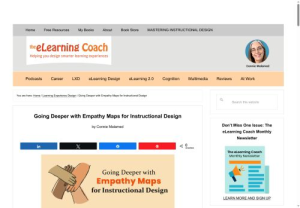Showing bookmarks tagged with: design
Clear
5 Creative Lecture Hall Installations That Optimize Space and ROI
https://www.sediasystems.com/blog/creative-lecture-hall-installations-that-optimize-space-and-roi
Take your lecture hall installations to the next level while strategically staying within budget and space constraints with these 5 inspiring installation concepts.
The future of campus classrooms | Queen's Gazette
https://www.queensu.ca/gazette/stories/future-campus-classrooms
Queen’s University has established itself as a leader in Canadian higher education when it comes to the creation of innovative classrooms that support dynamic styles of teaching and learning. It has invested in more than 20 spaces in recent years that promote the use of technology and active learning with features like movable chairs and multiple whiteboards or screens. Now it has adopted a strategic framework that builds on this success and will help ensure the campus has spaces that support the current and future needs of students and instructors.
Game design is simple, actually – Raph Koster
https://www.raphkoster.com/2025/11/03/game-design-is-simple-actually/
So, let’s just walk through the whole thing, end to end. Here’s a twelve-step program for understanding game design. One: Fun There are a lot of things people call “fun.” But most of them are not u…
Going Deeper with Empathy Maps for Instructional Design
https://theelearningcoach.com/lxd/empathy-maps-for-instructional-design/
Empathy maps help learning designers see beyond surface-level traits to better grasp what motivates and challenges their audiences.
Selected text
Empathy maps bring learners’ perspectives into sharper focus, revealing insights that can transform how you design and create learning experiences
The Teaching Game: Strategic Course Design
https://sandbox.darcynorman.net/course-design-game/
a silly Claude-coded game based on my dissertation. maybe 2/3 playable? but maybe something interesting in there somewhere…
The Fuzzy Front Ends: Reflections on the Never-Ending Story of Visualization Co-Design
https://altvis.github.io/papers/2025/FuzzyFrontEnds.pdf
Co-design is an increasingly popular approach in HCI and visualization, yet there is little guidance on how to effectively apply this method in visualization contexts. In this paper, we visually present our experience of a two-and-a-half-year co-design project with the local arts community. Focusing on facilitating community exploration and sense-making around arts funding distribution, the project involved a series of co-design sessions between visualization researchers and members of the arts community. Through these iterative sessions, we built shared understanding and developed visualization prototypes tailored to community needs. However, the practice is far from complete, and we found ourselves continually returning to the “fuzzy front end” of the co-design process. We share this ongoing story through comic-style visuals and reflect on three fuzzy front ends that we encountered during the project. By sharing these experiences with the visualization community, we hope to offer insights that others can draw on in their own community-engaged co-design work.
Civic Education in the Age of AI: Should We Trust AI-Generated Lesson Plans? – CITE Journal
https://citejournal.org/proofing/civic-education-in-the-age-of-ai-should-we-trust-ai-generated-lesson-plans/
Abstract
Generative artificial intelligence (GenAI) technologies can offer vast professional resources for teachers, empowering them to differentiate their practice, create curricular materials, and generate lesson plans for any topic. But should these novel tools to generate classroom activities and learning experiences be trusted? This study investigates 310 AI-generated lesson plans, featuring 2,230 learning activities, created by ChatGPT, Gemini, and Copilot for the 53 content standards mandated in the Massachusetts eighth-grade United States and Massachusetts Government and Civic Life curriculum. The AI-generated plans were evaluated for impacts on student thinking skills using Bloom’s Taxonomy and inclusion of diverse content using James Banks’ Four Levels of Integration of Multicultural Content Model. Analysis of the data revealed that the AI-generated lesson plans rarely cultivated higher order thinking or introduced diverse perspectives in each lesson. Regarding the potential of GenAI to support teachers with instructional tasks, we recommend that teachers critically evaluate and revise AI-generated lesson plans to provide more expansive, creative, and critical learning experiences.
I'm curious how this might connect to SMARTIE 2.0, which we're using to explore AI tools to support course design.
Online Learning Can Be Engaging and Effective
https://hrheingold.medium.com/online-learning-can-be-engaging-and-effective-87200d37dc62
"Online learning, done right, can be a delight — and achieve learning objectives. It appears that teaching online by necessity rather than aspiration has led to a many online attempts at learning that have fallen short of the mark, leaving those who were forced into it unsatisfied with the outcome and sometimes outright hostile to the whole idea."
Now More Than Ever: Why Collaborative Grading Works, Even Online
https://www.facultyfocus.com/articles/educational-assessment/now-more-than-ever-why-collaborative-grading-works-even-online/






